One of the most powerful forces on earth, volcanoes can be found in many unlikely places, including the state of Oregon. Most of us don’t even realize that the west coast is littered with both dormant and active volcanoes.
Oregon is home to 61 different volcanoes. Although we aren’t going to be exploring every single volcano, we’ll detail the prominent ones. First, we will run through a list of all volcanoes in Oregon. Second, we are going to pick the ones that are most important and exciting to know.
The 61 Volcanoes in Oregon
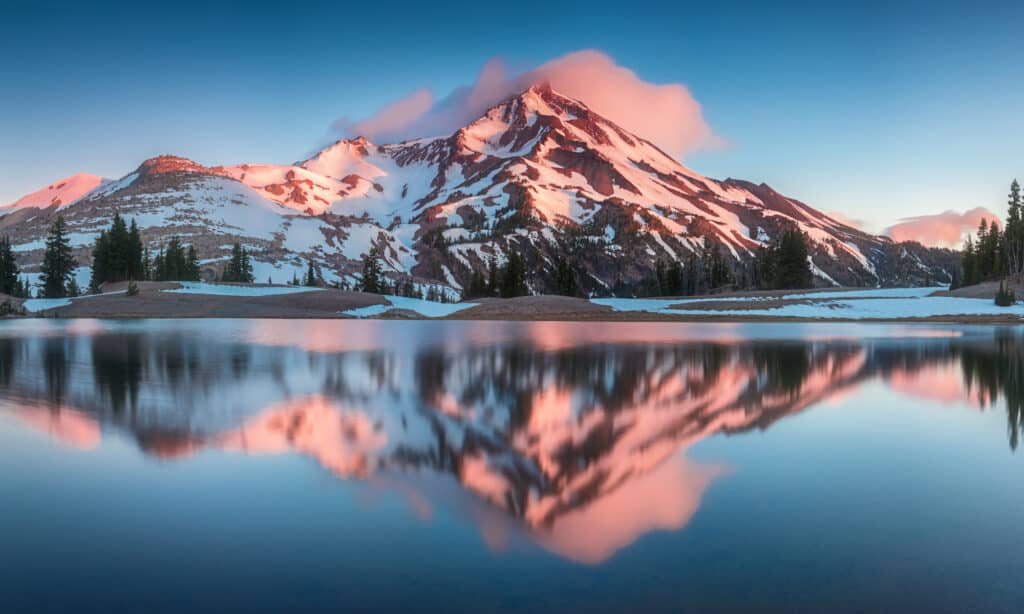
There are 61 named volcanos in Oregon including 5 active volcanoes.
©Michal Balada/Shutterstock.com
- Bachelor
- Bailey
- Belknap
- Big Bunchgrass
- Black Butte
- Black Crater
- Blue Lake Crater
- Boring Lava
- Broken Top
- Brown Mountain
- Cappy Mountain
- China Hat-East Butte
- Cinnamon Butte
- Cowhorn Mountain
- Crater Lake
- Cultus Mountain
- Cupit Mary Mountain
- Defiance
- Devils Garden
- Devis Lake
- Diamond Craters
- Diamond Peak
- Fort Rock Volcanic Field
- Four Craters
- Four Craters Lava Field
- Fuji Mountain
- Goose Nest
- Imagination Peak
- Irish Mountain
- Jackies Butte
- Jefferson
- Jordan Craters
- Lava Butte
- Lava Mountain
- Lost Lake Butte
- Maiden Peak
- McLoughlin
- Mount Hood
- Mount Washington
- Mountain Lakes
- Newberry
- North Sister
- Olallie Butte
- Pelican Butte
- Quartz MountainRed Top Mountain
- Saddle Butte
- Sand Mountain
- Scott Mountain
- Silver Creek
- South Sister
- Sprague River Valley
- Squaw Ridge
- Taylor Butte
- Thielsen
- Three Fingered Jack
- Three Sisters
- Tumalo
- Williamson Mountain
- Wilson
- Wuksi Butte-Twin Lakes
According to the United States Geological Survey, Oregon has 5 active volcano systems. These volcanoes have had activity in recent times.
These volcanoes include:
- Mount Hood
- Mount Jefferson
- Three Sisters (North Sister, Middle Sister, and South Sister)
- Newberry
- Crater Lake.
Being labeled an active volcano doesn’t mean they’ve erupted in recent years or even in our collective memory. For example, Crater Lake last erupted almost 5,000 years ago, though it had an earthquake in 2015.
Levels of Volcanic Activity
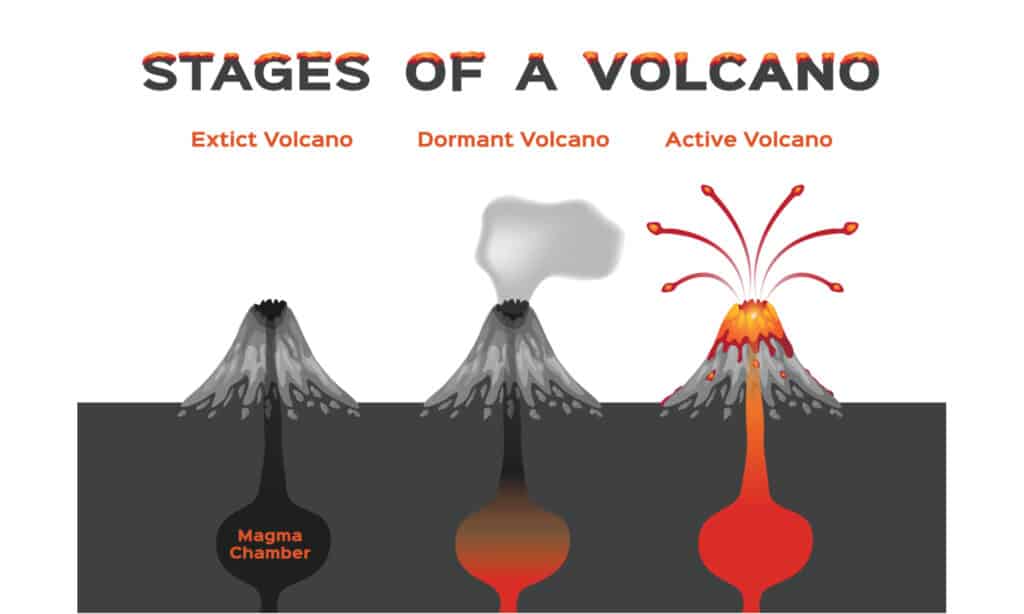
The three volcanic labels for activity levels are active, dormant, and extinct.
©gritsalak karalak/Shutterstock.com
There are three labels for volcanic activity levels: active, dormant, and extinct. Active volcanoes have experienced any sort of activity in recorded times and still have pockets of magma.
Dormant volcanoes have not experienced any activity in about 6,000 years, including seismic activity, but still could.
Extinct volcanoes haven’t had activity in thousands of years and don’t show connections beneath the earth’s crust any longer.
Many volcanoes can be considered active, but it doesn’t mean they are at risk of erupting. Scientists take a lot of factors into consideration when labeling a volcano as active, dormant, or extinct.
Plenty of testing of material around the volcanoes, seismic activity, and what we glean from recorded history tells us so much. It is incredible what we can learn about volcanoes now with the equipment we have.
Active Volcanoes in Oregon
The volcanoes we will dig into today are all considered active volcanoes by scientists.
Oregon coasts along the edge of the Ring of Fire, which is a string of volcanoes that make up the most active volcanic area in the world. This state is home to lush nature and beautiful topography, mainly thanks to the volcanoes of the site, which rebuilt the land in the past.
The area is fantastic to explore with excellent hiking trails and abundant Oregon wildlife. Knowing that some of these volcanoes are considered to have a high threat activity level just makes it even more thrilling.
Mount Hood
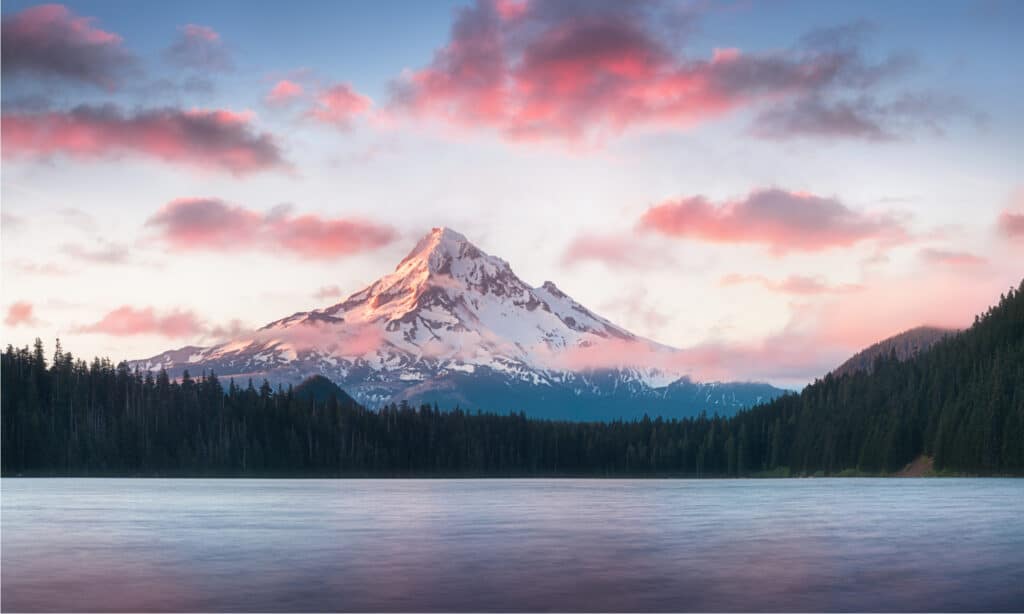
Mount Hood is a dormant stratovolcano that last erupted in the 1800s.
©Michal Balada/Shutterstock.com
First, we will explore the history and recent activity of Mount Hood. Of course, this volcano is located in Oregon, just like the rest will be.
This volcano is considered a dormant volcano, with the last eruption occurring in the 1800s. Dormant can still be active, though, mainly because it last erupted so recently.
With a history of decimating the local area, one can only hope that this volcano doesn’t erupt anytime soon. It hasn’t shown any signs of it, but the debris and mudflows flung out by the volcano can cause real change in the landscape.
Mount Hood is a stratovolcano, which has grown over thousands of years and with multiple materials. Likely, it was different types of volcanoes before developing into what it is now.
If Mount Hood were to erupt, it could change everything about the state of Oregon. It is not considered a high threat currently. The main issue would be that it could spread dangerous materials such as ash and cause avalanches if it erupted.
Some people actively live on Mount Hood, and it is known for being an incredible mountain to explore. An eruption could also affect rivers and nearby populations of people. It is the sixth most dangerous volcano, as stated in National Geographic.
Mount Jefferson
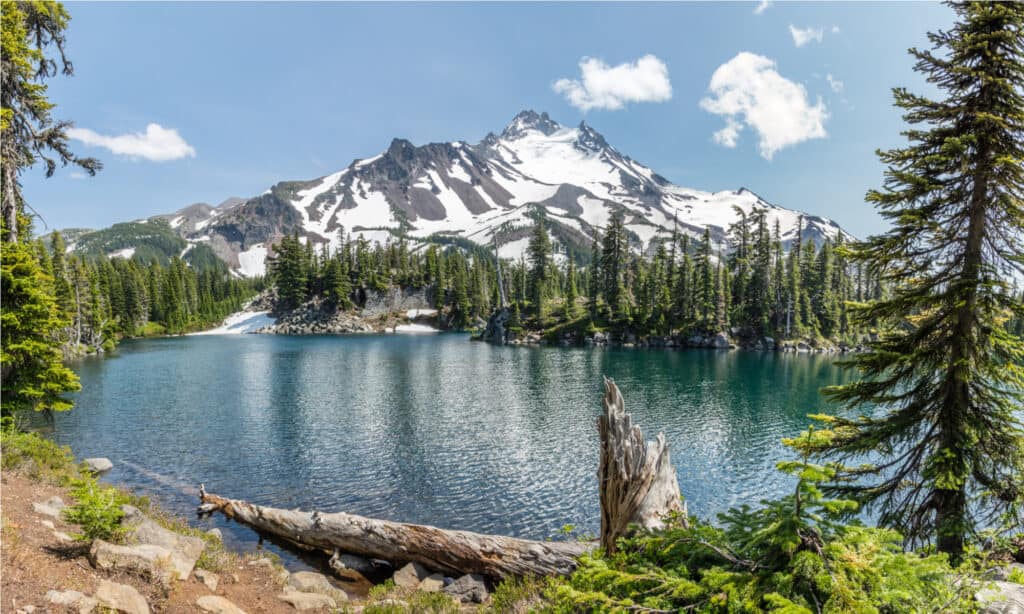
Mount Jefferson has developed over time into a complex volcano.
©Peter K. Ziminski/Shutterstock.com
This volcano is considered an active volcano. Like Mount Hood, it is a stratovolcano. Mount Jefferson had many series of eruptions in its early era that contributed to its development into a more complex volcano.
While the last notable eruption was around 15,000 years ago, Mount Jefferson still shows signs of being active even as it deals with natural decline. The second highest mountain in Oregon, it garners enough attention despite its lack of actual activity.
Lack of eruptions has caused this great giant to erode, but that doesn’t change that it was a once-powerful volcano that could grow stronger instantly. Tourists love exploring the rugged terrain, and Mount Jefferson can be seen all the way from the town of Salem on a nice, clear day.
The erosion that Mount Jefferson has endured means it is one of the most wasted volcanoes to be found in Oregon, having been broken down significantly. The history of this volcano is limited because there isn’t much that has been recorded until recent years.
Scientists do their best to learn more about it, but it’s challenging. We know that if Mount Jefferson were to erupt, it could cause major landslides that would reach far and destroy surrounding areas.
Three Sisters
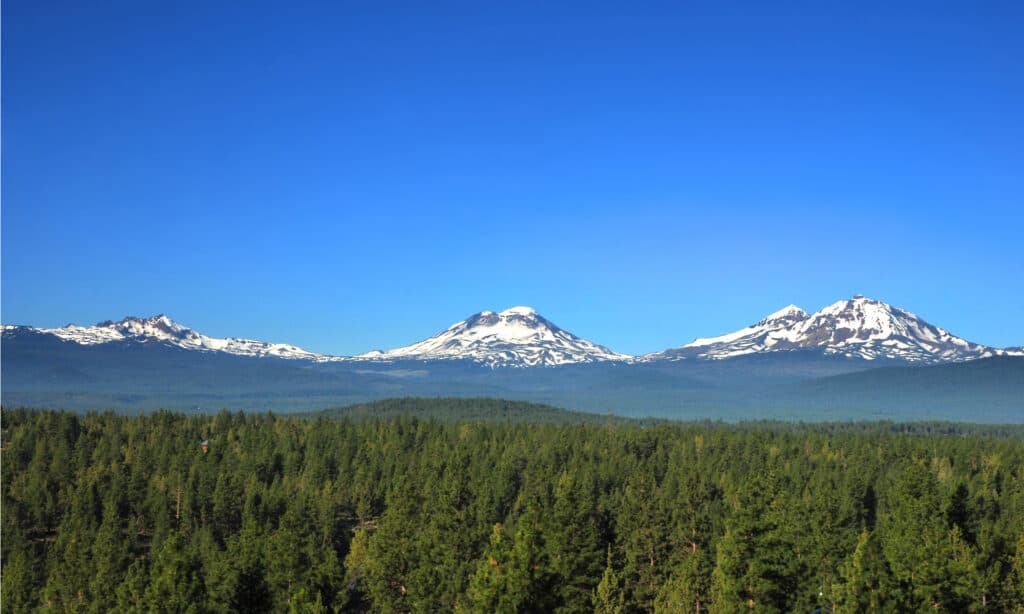
The three sisters are three volcanoes very close to one another with active lava flow.
©Karin Hildebrand Lau/Shutterstock.com
The three sisters are, in fact, three separate volcanoes. First, there’s North Sister. Second, there’s Middle Sister. Third, there’s South Sister. These volcanoes are very close together, enough to be grouped together as one feature.
While the last eruption was 2,000 years ago near South Sister, these volcanoes had exciting changes in 2021. Many earthquakes occurred, and the ground lifted a whole inch within one year. The Three Sisters are number seven on National Geographic’s list of most dangerous volcanoes in America, just after Mount Hood.
In 2022, the Global Volcanism Program released a report about the earthquakes that occurred in late 2021 and early 2022, partly caused by the recent uplift from the ground.
South and Middle Sisters are both stratovolcanoes, while North Sister is a shield volcano. A shield volcano is what most volcanoes start is from the ground. They release lava and pyroclastic material that spreads outward into a shield shape.
South Sister is the most active volcano of the three because it had the highest recent activity. North Sister is the oldest of the three. These volcanoes actively produce flows of lava, so they are all considered active.
Newberry
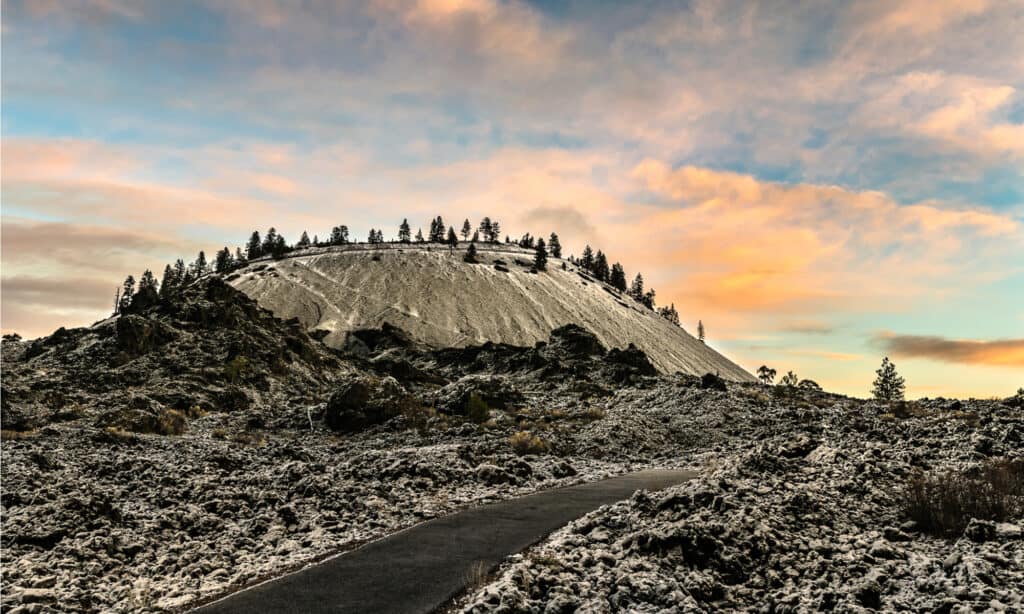
Newberry is a shield volcano with a “very high” threat level.
©Jason Cornell/Shutterstock.com
A shield volcano, Newberry spreads out over 75 miles and has more than 400 vents. Shield volcanoes eventually develop into other volcanoes because their vents shift, and a large enough eruption can form a different type of volcano.
Newberry is also an active volcano, having had its last eruption 1,300 years ago, and has active lava flow and many vents reaching down. Its threat level is considered “very high.”
There are two caldera lakes within this volcano. Calderas form when eruptions are too large and destroy part of the volcano. Then a depression results, which is the caldera, and it eventually fills with water to form lakes.
The Newberry calderas were originally one lake but separated into two lakes. Newberry can be a popular destination for tourists as it has a series of hot springs along it.
Mount Mazama
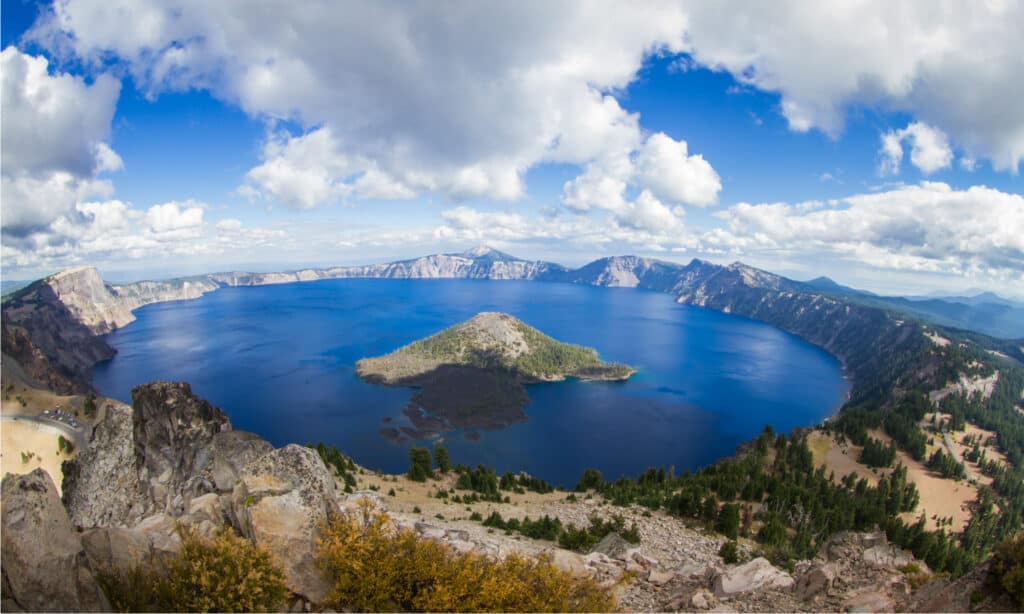
Crater Lake, which was formed from the collapse of Mount Mazama, is the deepest lake in the United States.
©Wollertz/Shutterstock.com
The seventeenth most dangerous volcano on the National Geographic‘s list, Mount Mazama had the largest eruption in the entire area for the last 100,000 years. That is part of what collapsed the center of this volcano, leading to the formation of its caldera, which filled with water to become Crater Lake.
A popular tourist destination, Crater Lake National Park is open to the public to go forward and explore. Crater Lake is the deepest lake in the United States and has the clearest water in the world.
Mount Mazama is considered a dormant volcano as it hasn’t had an eruption in more than 7,700 years. That doesn’t mean something might not happen in the future. Volcanoes are volatile, after all.
Summary of Volcanoes in Oregon
Here’s a recap of the volcanoes in the state of Oregon that we took a close look at:
| Number | Volcano | Status | Last Eruption |
|---|---|---|---|
| 1 | Mount Hood | Dormant | 1800s |
| 2 | Mount Jefferson | Active | About 15,000 years ago |
| 3 | Three Sisters | Active | 2,000 years ago |
| 4 | Newberry | Active | 1,300 years ago |
| 5 | Mount Mazama | Dormant | 7,700 years ago |
What U.S. States Have Active Volcanoes?
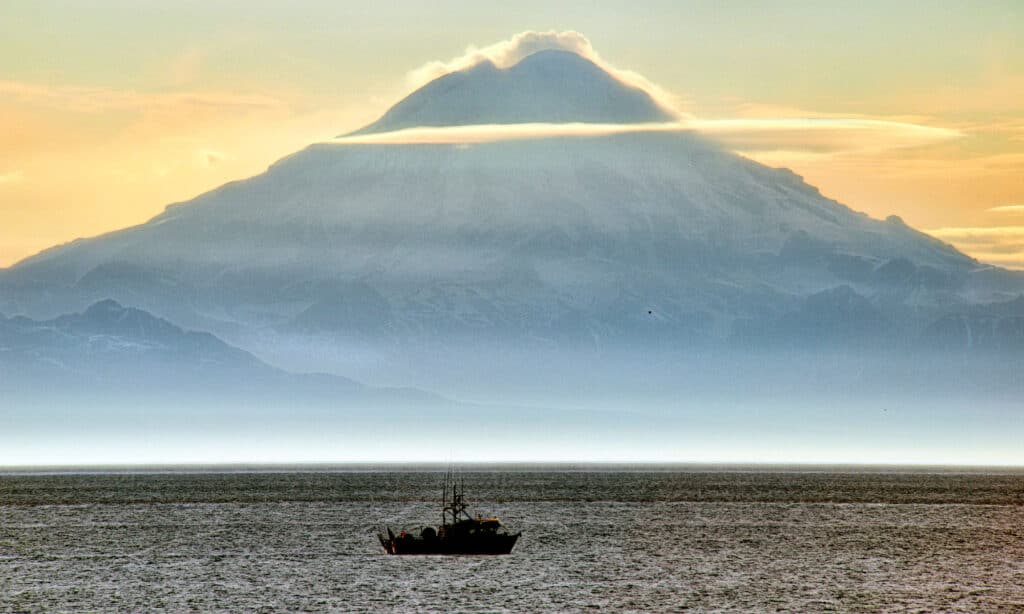
Redoubt Volcano is one of the most dangerous in Alaska.
©iStock.com/David Arment
Mt. St. Helens is certainly the most famous active volcano in the United States, but were you aware that there are over 190 active volcanoes in the U.S.? The volcanoes are spread out across 11 different states, with one state–New Mexico–up for debate, as there is conflicting information on whether or not it has active volcanoes. Below is a list of the states with active volcanoes, along with how many are in each state.
- Alaska – 141
- Utah – 19
- California – 7
- Hawaii – 6
- Washington – 5
- Oregon – 5
- Idaho – 4
- Arizona – 3
- Nevada – 1
- Wyoming – 1
- Colorado – 1
The volcanoes in Alaska, amazingly, almost all of the 140 volcanoes are concentrated along the Aleutian Range and the Aleutian Islands. The most common threats from these volcanoes are ash clouds and ashfall. One of the most dangerous volcanoes in Alaska is Redoubt Volcano, a 9,000-foot high stratovolcano that has erupted five times since 1900.
The photo featured at the top of this post is © Michal Balada/Shutterstock.com
Thank you for reading! Have some feedback for us? Contact the AZ Animals editorial team.






